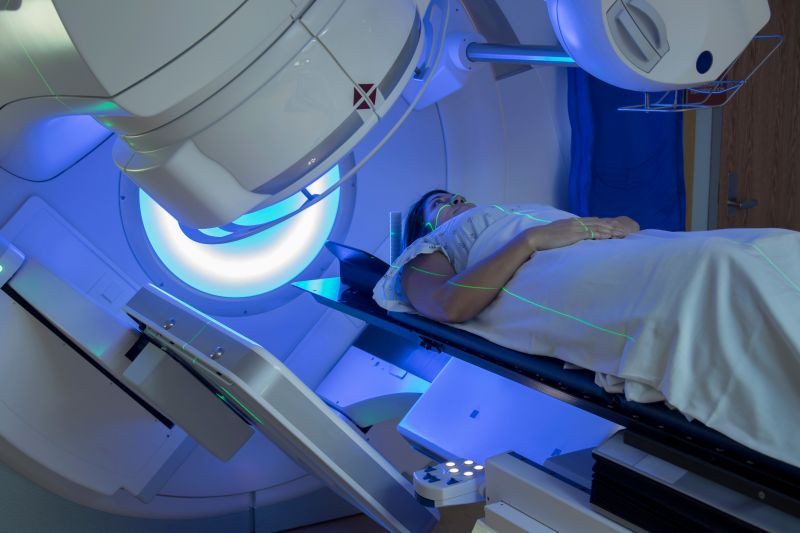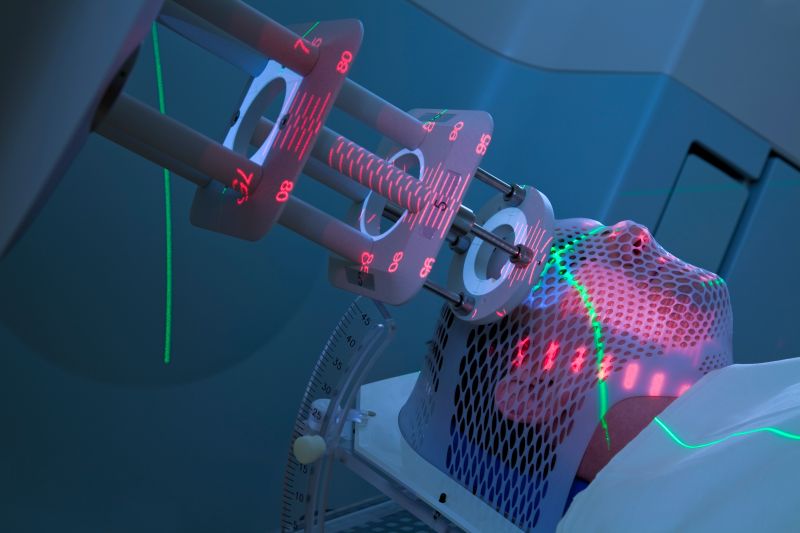Radiation Therapy for Cancer: Types, Risks, Procedures, and Side Effects
Radiation therapy is a cancer treatment that uses powerful beams of energy to kill cancer cells and shrink tumors. In very low doses, radiation is the technology that allows x-rays to provide visibility inside your body. This is usually referred to Radiology and not to be confused with Radiation Therapy.

Treatments for more than half of all cancer patients involve radiation therapy. It is used in treatment of many forms of cancer but not limited to: lymphomas, lung cancer, gastrointestinal cancers, brain tumors, head and neck cancers, etc. Radiation therapy treatment is also useful for treating certain types of benign, non-cancerous conditions such as meningiomas, schwannomas, arteriovenous malformations, etc.
How Does Radiation Therapy Work?
Radiation therapy kills cancer cells or prevents their growth by destroying their genetic material (DNA), which they need to grow and divide. When the DNA inside cancer cells is destroyed or damaged, the cells will either cease to divide or die. After a cancer cell dies, it is broken down and removed by the body’s natural processes.
Radiation therapy may damage both healthy and cancerous cells. The aim of this treatment is to destroy the fewest amount of healthy body cells as possible while maximizing the destruction of cancerous cells. Any side effects is usually result of damage to healthy body cells. That’s why areas at highest risk of side effects in radiation therapy are the organs in immediate vicinity or close to the tumor. They receive a part of the radiation en-route to the tumor. Modern and advanced radiation therapy techniques have developed many tools to minimize this.
Cancer cells do not die right away after they are exposed to radiation therapy. It takes several days or sometimes weeks before the cancer cells’ DNA is damaged to the point that the cells cannot survive. After radiation therapy is complete, cancer cells continue to die for weeks or months. This is why the tumor itself can take weeks or months to shrink in size. On many occasions, the tumors might not completely disappear but instead leave a scar in its place, which will be visible on all subsequent imaging studies.
Types of Radiation Therapy
There are two different types of radiation therapy, referred to as external beam radiation therapy and internal radiation, or brachytherapy. Each also have many different subsets of their own.
The type of radiation a patient receives is dependent on a few factors. Some of these factors include the type of cancer, the size and location of the tumor, and a patient’s health and medical history. Doctors will also take into consideration whether a patient requires other types of cancer treatment before recommending a certain type of radiation therapy.
External Beam Radiation Therapy
When people use the term “radiation therapy,” they are most commonly referring to external beam radiation therapy. This type of radiation involves an external machine directing high-energy beams toward a precise point of a patient’s body.
External beam radiation machines are large, and they move around the body in order to direct radiation toward the body from different directions. The machines administer radiation without physically contacting a patient’s body.
Brachytherapy/Internal Radiation
Internal radiation therapy differs from external radiation therapy in that the source of radiation is placed inside a patient’s body. Internal radiation sources can be either liquid or solid.
If the source of internal radiation is a solid, the therapy is referred to as brachytherapy. This type of treatment involves putting small objects, such as radioactive seeds or needles, in or near the tumor in a patient’s body. As such, internal radiation therapy targets one specific part of the body and has the ability to deliver very large doses while minimizing damage to surrounding tissues. Brachytherapy has a wide range of applications in certain cancer types, like prostate cancer or cervical cancer.
When the internal radiation source is an injectable liquid, the treatment is referred to as radiopharmaceutical therapy. Since it is injected into your body, it will look throughout your body as it circulates in your blood to target any cancerous cells it encounters.
Another form of radiopharmaceuticals is radioactive iodine treatment. This is usually ingested orally in the form of a capsule. It is then absorbed into your blood and circulates looking for any thyroid cancer cells it encounters.
When is Radiation Therapy Used?
The majority of cancer patients will require radiation therapy at some point. This could be either in regimens where cure is the goal or in settings where goal is for palliation/improving symptoms, such as treating large bone metastases that are causing pain or tumors that are dangerously bleeding.

The use of radiation therapy may cure the cancer, slow or stop its growth, and/or prevent it from returning.
Types of Cancer that are Treated with Radiation Therapy
As previously stated, radiation therapy plays a role in treatment of most cancers. It is a common component of most cancer patients’ treatment plans.
Given the complexity of determining which cancer type is best treated with the best modality of radiation therapy, please consult your radiation oncologist. You can also make an appointment here or reach out to our Dallas Fort Worth Texas Oncology office to schedule an official consultation at 817-413-1532.
How is Radiation Therapy Used along with Other Cancer Treatments (Surgery and Chemotherapy)?
For some patients, radiation therapy is the only course of cancer treatment necessary. However, most of the time, patients receive some combination of treatments including radiation, surgery, chemotherapy, and immunotherapy.
Doctors can administer radiation therapy before, during, or after other types of treatment. It could be given either before, during, or after surgery in certain cancers. The exact timing of radiation therapy depends on the type of cancer a patient needs treatment for. It also depends on whether the goals of the treatment are palliative or curative.
When radiation therapy is given before surgery, it is done to diminish the size of the tumor or cancer so a surgeon can remove it more easily. This also decreases the chances that the cancer will return.
Radiation therapy can also be given during surgery. This gives the radiation more direct, targeted access to the cancer because it does not have to travel through the patient’s skin. It also protects nearby organs and tissues from the damage caused by radiation. This procedure is called intraoperative brachytherapy.
Finally, radiation therapy may be used following surgery to kill any remaining cancer cells that are left in the body post-operation. This helps increase the likelihood of recovery from cancer and decreases the chance that cancer will develop at that location again after treatment is complete.
Radiation therapy can also be given either before, during, or after a course of chemotherapy.
Radiation Therapy Side Effects
Because radiation therapy can damage healthy tissues and cells that are near cancerous cells, the treatment can cause some side effects.
One of the most common side effects of radiation therapy is fatigue. This side effect is not dependent on the location of the cancer inside the patient’s body.
Most other radiation therapy side effects depend on which area of the body receives the treatment. For example, if you are receiving abdominal radiation, nausea or diarrhea might be common side effects but hair loss not likely. According to the National Cancer Institute, here are some common side effects for treatment of various body parts:
- Head and Neck: Dry mouth, thickened saliva, trouble swallowing, sore throat, changes in ability to taste, nausea, mouth sores, tooth decay
- Chest: Difficulty swallowing, cough, shortness of breath
- Abdomen: Nausea, vomiting, diarrhea
- Pelvis: Diarrhea, frequent urination bladder irritation, sexual dysfunction
Communicate with your doctor about any side effects you may experience from radiation therapy. Any healthy cells that have been damaged by radiation therapy will typically recover within a few months following treatment. However, certain side effects referred to as late effects may develop long after treatment is complete.
The development of late effects depends on several different factors. Some of these factors include which part of the patient’s body received treatment, which other cancer treatments a patient has received, genetics, and other aspects of a patient’s health history.
How Much Does Radiation Therapy Cost?
The cost of radiation therapy varies depending on what type of radiation therapy you need, how many treatments are required, your health insurance company, and the cost of health care where you live. The cost of radiation therapy accounts for the use of expensive machines as well as the medical services of multiple health care providers.
Check with your local radiation therapy center to find out the cost for your treatment. If you would like a second opinion, you may book an appointment here or contact our Dallas-Fort Worth Texas Oncology Center at 817-413-1532 for a formal consultation.